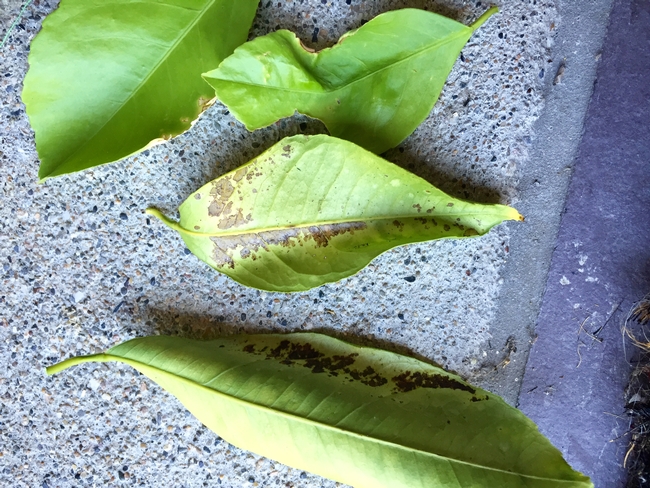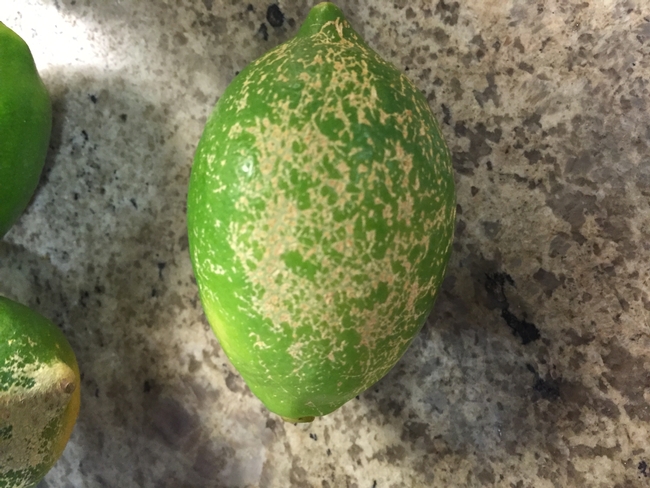Advice from the Help Desk of the
UC Master Gardener Program of Contra Costa County
MGCC Help Desk Request:I am located in Central County. I am having issues with my lemon tree. I have attached some photos. I was hoping you could give me some advice.
I have never sprayed pesticides. I am hoping for a more organic solution to the issues. I know it might not be possible.
I have not fertilized it this year. It is on our sprinkler system so it gets water daily. Some of the leafs have spiderweb looking substance under the leafs. Some leafs are yellow. I have also noticed the spikes are very large. Thank you so much for your help.


MGCC Help Desk Response: Thank you for contacting UC Master Gardener Program with your lemon tree questions and for sending the photos. The symptoms you are seeing could be the result of various minor problems that occur on citrus. The curled leaves show signs of citrus leaf miner. Citrus leaf miners are moth larvae that create shallow tunnels in young leaves. They can distort the leaves but are generally not harmful to the tree. You are probably seeing the end result of leaf miner damage that was done previously. For more information on citrus leaf miners, see: http://ipm.ucanr.edu/PMG/PESTNOTES/pn74137.html.
We are not sure about the spiderweb type substance. It could be from an insect, e.g., whiteflies, but if so you should also find sticky areas on the leaves. Also, any pictures of the insect would be helpful. It is also possible that there are spiders on your tree. If that is the case, I would not worry. If you want the spider identified, see if you can get a photo and we will try to identify it.
The fruits look like they may have been damaged by the thorns which you indicated are very large. That would happen if the fruits were rubbing against the thorns. Is that possible? If not, another possibility would be herbicide damage. Is it possible that herbicides were used anywhere near the citrus tree? Even your neighbors? Make sure you remove the damaged fruits from the tree before we have any more rain. The damaged areas provide an opening for fungi and other diseases to get into the tree. Also, large thorns might indicate that the branch is a juvenile branch or is coming from below the graft, the "bump" near the bottom of the trunk. If from below the graft, you should consider removing that branch as it probably will not produce edible fruit.
The spots on the leaves may be from a fungus. The fungus may be the result of the watering, especially if the sprinkler system is putting water on the leaves. Make sure that the sprinkler is set low and also make sure that the sprinklers are not dampening the tree trunk. Wet tree trunks can lead to root or crown rot from fungus growing around the roots and crown (where the roots and trunk meet). Root and crown rots are serious diseases that are difficult to treat and can ultimately kill the tree.
The daily sprinkling may also be causing other problems for the overall health of your tree. Daily watering might not be supplying the citrus with enough water. Citrus, like most trees, do best with less frequent, and deep watering to promote stronger roots. To give you an example of how infrequent the watering should be, watering in the heat of summer should be done about every seven to ten days. This would be for citrus planted in the ground and with several inches of mulch under the tree out to drip line. In a pot you would need more frequent watering as they dry out faster. If other plants on your irrigation system need frequent watering, you should consider setting up a separate irrigation system on a different timer for the lemon. For more information on watering citrus, see: http://ipm.ucanr.edu/PMG/GARDEN/FRUIT/CULTURAL/citruswatering.html.
You mentioned that you had not fertilized the tree this year. Yellow leaves are a common sign of a lack of nitrogen. Citrus trees require regular fertilization, especially with nitrogen. The fertilizer should be applied in January or February (prior to bloom) with a second application in May and perhaps a third in June. This link has more information on fertilizing citrus: http://ipm.ucanr.edu/PMG/GARDEN/FRUIT/CULTURAL/citfertilization.html.
Finally, I thought that you might be interested in this general write-up on growing citrus in Contra Costa County: //ucanr.edu/blogs/slomggarden/blogfiles/4260.pdf
Please let us know if you have any remaining questions. You are also welcome to bring plant samples into our office if you want more information. We are open Monday to Thursday, 9am to 12 noon.
Good luck with your lemon tree..
Help Desk of the UC Master Gardener Program of Contra Costa County (ECS)
Note: The UC Master Gardeners Program of Contra Costa's Help Desk is available year-round to answer your gardening questions. Except for a few holidays, we're open every week, Monday through Thursday for walk-ins from 9:00 am to Noon at 75 Santa Barbara Road, 2d Floor, Pleasant Hill, CA 94523. We can also be reached via telephone: (925) 646-6586, email: ccmg@ucanr.edu, or on the web at http://ccmg.ucanr.edu/Ask_Us/ MGCC Blogs can be found at http://ccmg.ucanr.edu/HortCoCo/ You can also subscribe to the Blog (//ucanr.edu/blogs/CCMGBlog/).